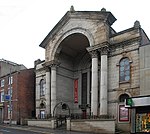Preston railway station

Preston railway station in Preston, Lancashire, England, is an interchange railway station on the West Coast Main Line, half-way between London Euston and Glasgow Central (206 miles (332 km) from London Euston, 194 mi (312 km) from Glasgow Central). It is served by Avanti West Coast, Northern Trains and TransPennine Express services, plus Caledonian Sleeper overnight services between London and Scotland. It is also served by the Calder Valley line to Leeds and York, and by branch lines to Blackpool, Ormskirk, and Colne. The North Union Railway opened a station on the site in 1838. It was extended in 1850, with new platforms under the separate management of the East Lancashire Railway, and by 1863 London–Scotland trains stopped here to allow passengers to eat in the station dining room. The current station was built in 1880 and extended in 1903 and 1913, when it had 15 platforms. A free buffet for servicemen was provided during both World Wars. The East Lancashire platforms were demolished in the 1970s as connecting lines closed. As well as intercity trains to London Euston, Birmingham New Street, Manchester Piccadilly, Glasgow Central and Edinburgh Waverley, the station is served by local trains to other parts of Lancashire, Cumbria, Greater Manchester, Merseyside and Yorkshire.
Excerpt from the Wikipedia article Preston railway station (License: CC BY-SA 3.0, Authors, Images).Preston railway station
Butler Street, Preston Avenham
Geographical coordinates (GPS) Address Nearby Places Show on map
Geographical coordinates (GPS)
| Latitude | Longitude |
|---|---|
| N 53.756 ° | E -2.7072 ° |
Address
Preston
Butler Street
PR1 2UH Preston, Avenham
England, United Kingdom
Open on Google Maps







